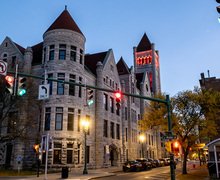Campaign funds more than 400 SU scholarships
Natalie Fowler was broke.
She had used her savings to pay her father’s mounting medical bills, a result of his cancer, and had nothing left to pay her Syracuse University tuition.
Despite her financial aid package, the freshman sports management major was considering transferring to a more affordable school when the Financial Aid Office contacted her and informed her she was eligible for Syracuse Responds grant money. She was thrilled.
‘The thought of leaving Syracuse left me depressed, because I did just invest four months of my time here,’ said Fowler, a freshman sports management major. ‘It was depressing to leave the wonderful professors and the friends I just made. As I found out I was going to get assistance, I was ecstatic.’
The Syracuse Responds Initiative, which began Dec. 5 with the goal of raising $2 million to help 400 students stay in school despite economic hardship, will end Saturday. The campaign relied on donations from alumni, faculty and others and raised more than $830,000. While this was less than half of its original financial goal, Syracuse Responds was still able to help more than 400 students.
Although the university fell $1,170,000 short of its original goal, there are currently no plans for another fundraiser to make up the difference, said Brian Sischo, associate vice president of development
‘I think we have to evaluate that as we go forward,’ Sischo said, ‘and certainly work in concert with enrollment management and financial aid to assess not only where we stand for this semester, but then in preparation for the fall as the new class comes in.’
While Saturday will bring an end to organized solicitation, if someone were to donate afterwards, the money would still go into the Syracuse Responds fund, he said.
Youlanda Copeland-Morgan, associate vice president for enrollment management and director of scholarships and student aid, said the reason the university has been able to help more than 400 students with less than half the original $2 million estimate is because of other methods of financial aid.
‘The help comes in the form of lots of different resources,’ she said. ‘We also draw on loans. We draw on work-study.’
Copeland-Morgan noted that more students sought financial aid during the spring registration period than previous years. She said that last year during opening weekend until the first day of classes the financial aid office had 101 walk-in students asking for help. This year it had 238.
Some students, like Dalan Dihn, were not able to receive grant money and could not return to SU this semester. Dihn had to transfer to American River College, a community college in Sacramento, Calif. this semester.
Dihn became a resident advisor and got a job as a teaching assistant to help her parents pay the bill. But tuition was too much of a burden, especially in the current economic climate, she said.
‘My dad is a real estate agent and he helped businesses develop,’ Dihn said. ‘Since the economy is so bad and all these businesses are shutting down, nobody wants to start a business. The economy has a direct effect on his job because he works directly off commission.’
The added strain of increasing flight costs from Sacramento to Syracuse also contributed to her decision to leave SU, Dihn said.
Dihn applied for emergency financial aid in November, but was denied because there were not available resources, she was told. By the time Syracuse Responds was created in December and she found out about it, she had already made the decision to leave.
She said she hopes to be able to return to SU in the fall if she receives more money from the Free Application for Federal Student Aid. Otherwise, she will transfer to a four-year school in California.
‘I miss the weather,’ Dihn said. ‘I know that’s weird to say, but it’s like 63 degrees here and I love this blue sky, but I do miss the snow. I miss waking up to seeing snow every morning. I miss my friends. I totally miss being a resident advisor, and I totally miss my teaching assistant job.’
Those who were able to finish their time at SU took time to raise funds for the campaign.
Eric Gleason, an ’05 alumnus, received an e-mail about the initiative in early December and decided help by donating his time to organize a fundraising party.
Gleason, along with other alumni, Doug Serton, ’04 and Michael Moscardini, ’02, planned a party in the name of their late Theta Chi fraternity brother, Chris Sawyer, ’04, who died two years ago from lymphoma.
‘He loved people, and he loved Syracuse University,’ Gleason said. ‘That was one of our main motivators. This was an appropriate thing to do in his name.’
The three were able to raise $1,500 through ticket sales, a silent auction of SU athletic memorabilia donated by the university’s athletics department and donations from people who were unable to attend.
Some alumni chose not to donate to the initiative. Kristen Krikorian, a 1999 alumna and president of Boston Alumni Cub, said she first read about the initiative online. She said she understood that with the poor economy, students need the extra help. She believes Syracuse Responds is a great way to raise those extra funds, she said, but ultimately decided not to donate.
‘Because I’m president of the Alumni Club,’ Krikorian said, ‘I feel like I give Syracuse a lot of my time and energy and even funds, in terms of running the club and organizing events. I feel like that’s my donation at the moment.’
Published on January 27, 2009 at 12:00 pm





